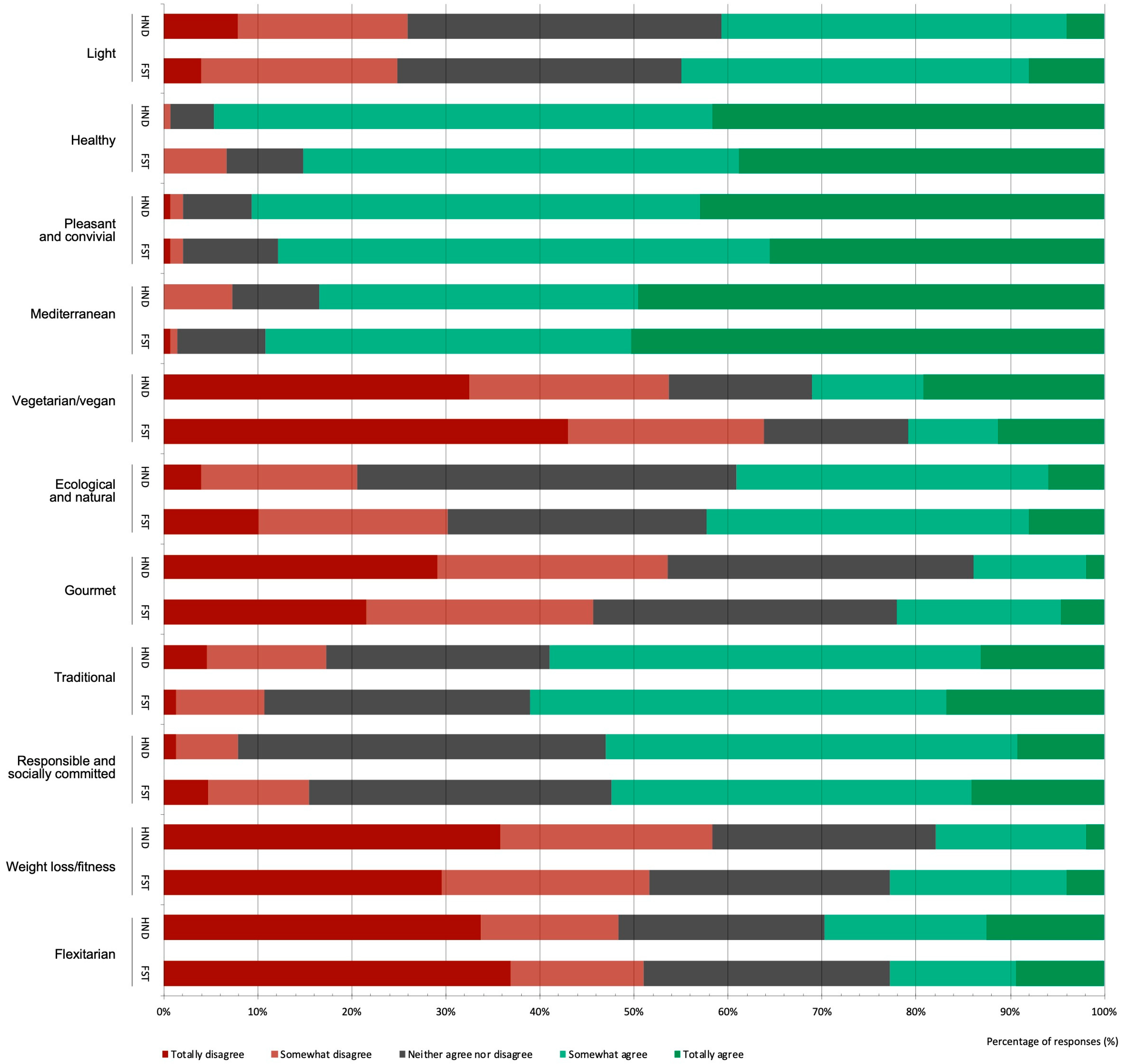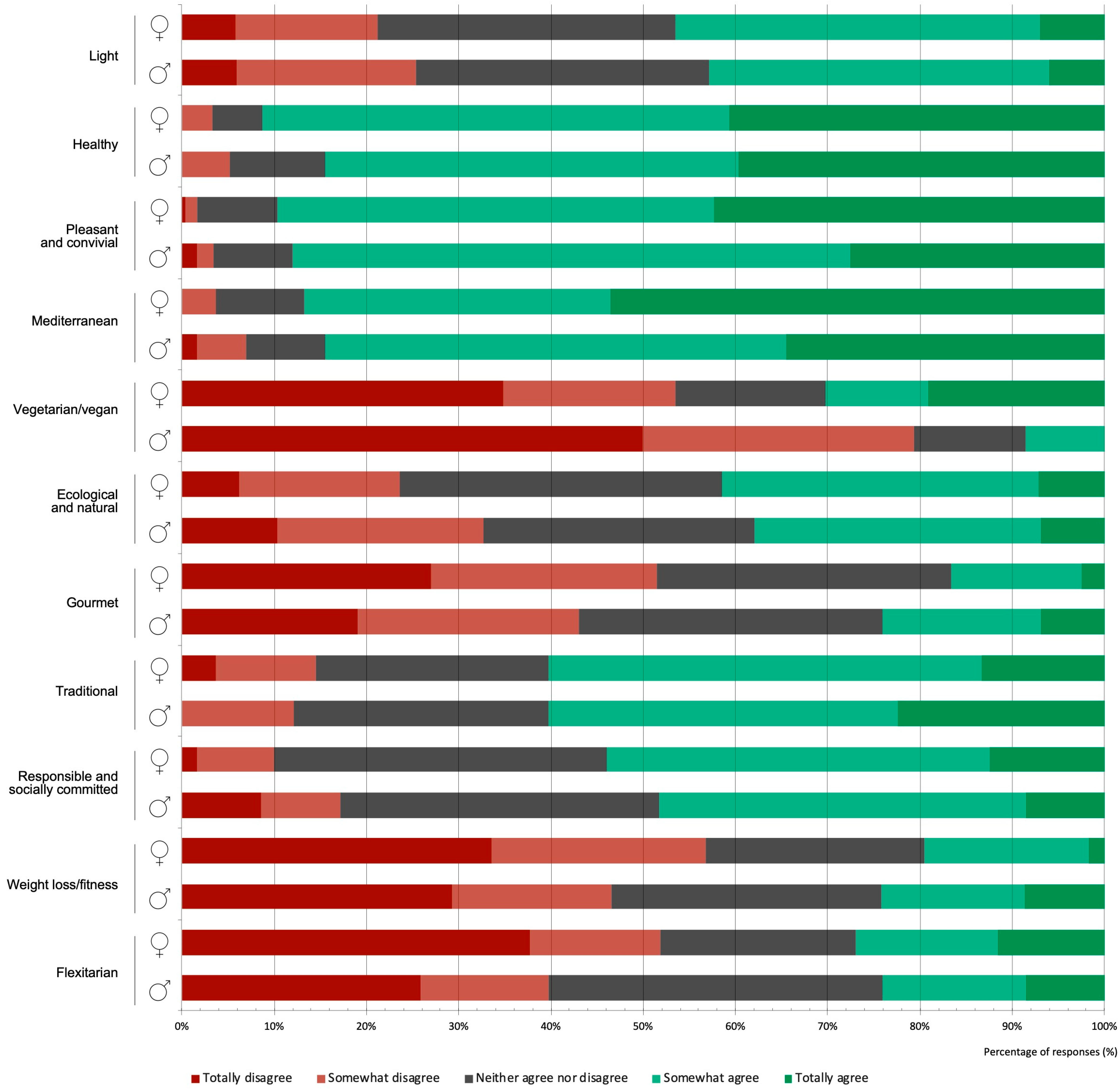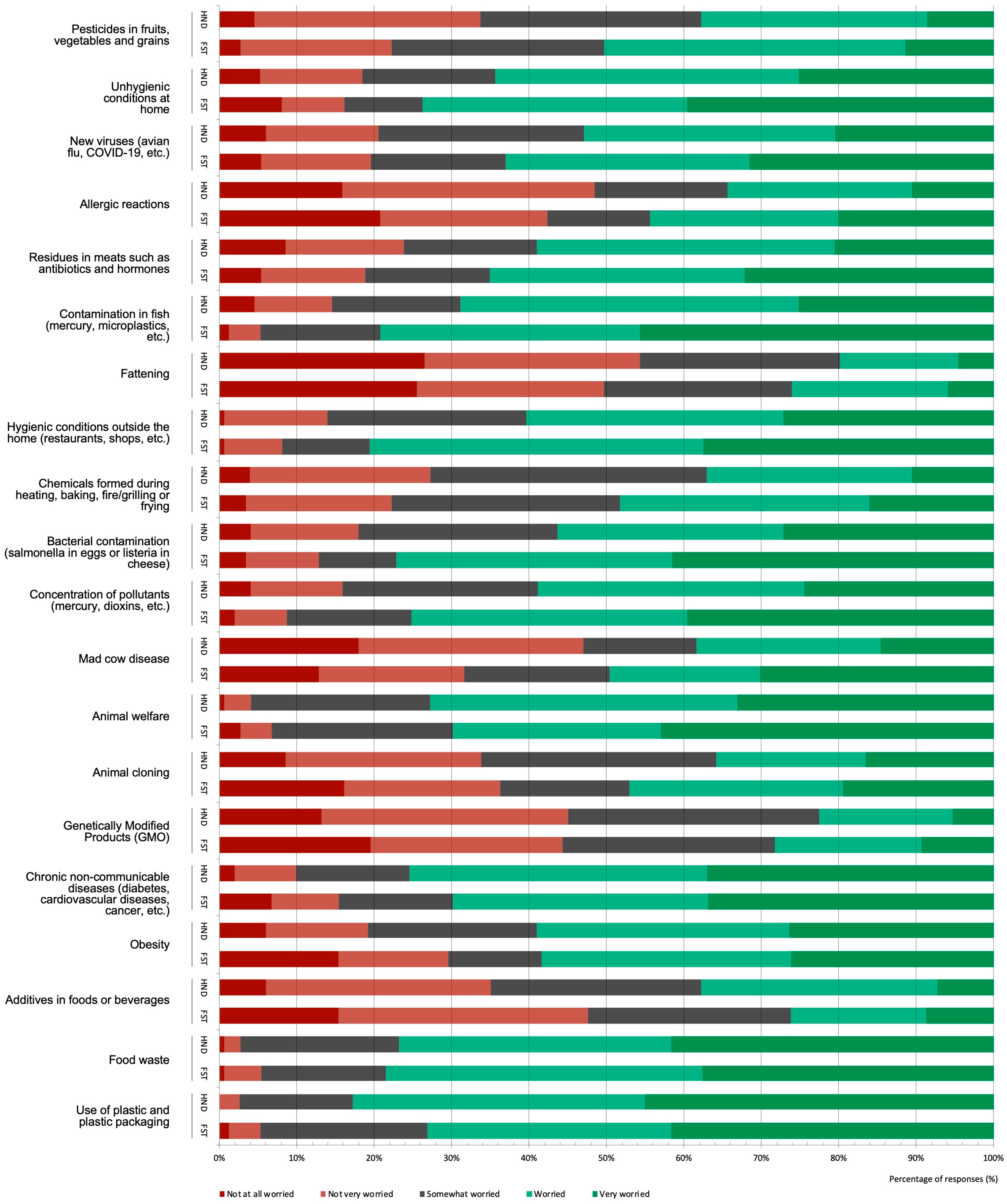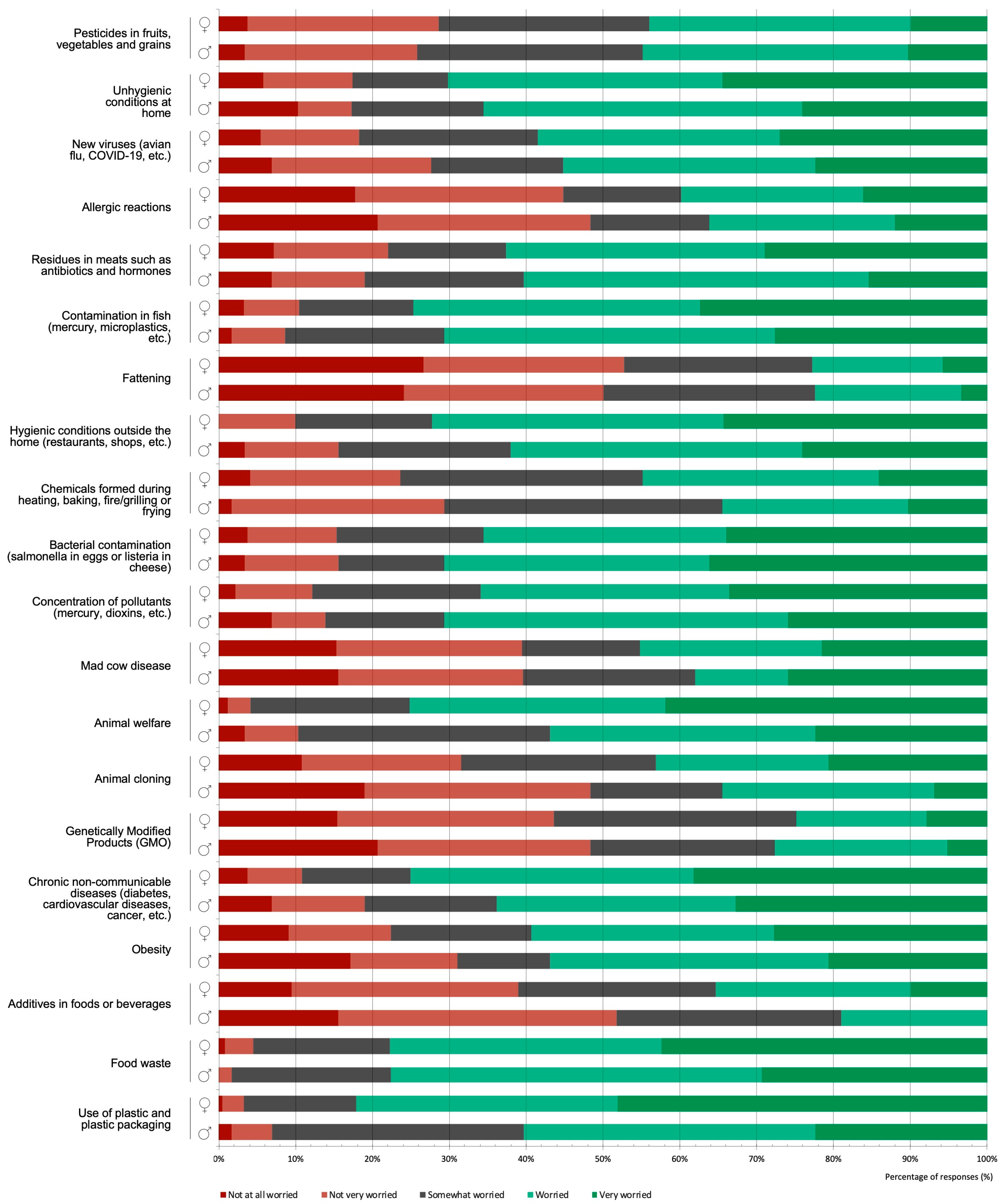Perceptions of Food among College Students in the Field of Food Science: A Food Sustainability Approach
Abstract
1. Introduction
2. Materials and Methods
2.1. Setting and Sample
2.2. Data Production and Analysis
3. Results
3.1. Participant Profile
3.2. Food Perceptions and Choice
“The first thing is to get nourishment, nutrition, but then also to enjoy the food as such, uh... to share it, as a means of social connection”(Carlos, HND).
“I don’t eat meat and when I avoid certain foods, I do it because of that, because of sustainability or the origin, things like that. (...) I started when I was very young because of the animals, the little animals. Now, it’s because of sustainability and, to some extent, inertia”(Amanda, HND).
“Sustainability, that’s why I started and why I continue [to avoid eating meat]. In other words, that’s why I’m not very strict, because I understand that maybe [eating] a small amount of meat won’t change the current situation of the meat industry. But it’s true that I limit it a lot and I try to make those around me aware of the carbon footprint of meat consumption”(Elena, FST).
“I think I’m a mixture of everything because I’m influenced by the taste something has. Obviously, [I’m aware of] the impact it’s going to have on the environment, but I’m also very much a person who takes whatever happens to be in the fridge, especially as I live with my parents. And as my grandparents were farmers, they have a garden and we have a lot of products from my grandparents’ garden, so I eat a lot of what’s in season … so I think the factor that most determines what I eat is whether it’s in season or not”(Gemma, HND).
“I’m trying to cut down on calories a little, I try not to eat too many carbohydrates and I also try to eat as little processed food as possible (…) this seems obvious to me, for health reasons”(Samanta, FST).
“I try not to eat genetically modified food, I make sure it’s organic, or at least that there are no genetically modified organisms or excessive pesticides, herbicides, that it’s not agribusiness”(Amanda, HND).
“I try to have a little bit of sustainable food. I also try to look at where everything comes from”(Samanta, FST)
“I try not to consume [genetically modified organisms], and I go to markets and look for local products”(Alba, FST)
3.3. Food Concerns
“The issue of additives has changed a lot, because I used to be one of those people who went to supermarkets and saw a product with additives and others without additives, and bought the one without additives, but now I understand that if they are there, it’s for a reason. And not only that they are there for a reason, but that sometimes it is better that they are there than not”(Eric, FST).
“Before I started the degree, I regarded it as something more negative, and [now] I understand that it’s very regulated, that we have a lot of food legislation and we know that in the European Union, EFSA is regulating it”(Elena, FST).
3.4. Perceptions of a Sustainable Diet
4. Discussion
4.1. Social Perceptions Related to Food and Sustainability
4.2. Social Perceptions According to Gender
5. Conclusions
Supplementary Materials
Author Contributions
Funding
Institutional Review Board Statement
Informed Consent Statement
Data Availability Statement
Acknowledgments
Conflicts of Interest
References
- Garnett, T. What Is a Sustainable Healthy Diet? A Discussion Paper; Food Climate Research Network. 2014. Available online: https://hdl.handle.net/10568/35584 (accessed on 7 February 2022).
- Lang, T. Sustainable Diets and Biodiversity: The Challenge for Policy, Evidence and Behaviour Change. In Sustainable Diets and Biodiversity Directions and Solutions for Policy, Research and Action; Burlingame, B., Dernini, S., Eds.; FAO: Rome, Italy, 2012; pp. 20–26. Available online: https://www.fao.org/ag/humannutrition/25388-0233cb231772812fc33e3ec11333ffc20.pdf (accessed on 7 February 2022).
- Burlingame, B. “Preface”. In Sustainable Diets and Biodiversity Directions and Solutions for Policy, Research and Action; Burlingame, B., Dernini, S., Eds.; FAO: Rome, Italy, 2010; pp. 6–8. Available online: https://www.fao.org/3/i3022e/i3022e.pdf (accessed on 8 February 2022).
- Peano, C.; Merlino, V.M.; Sottile, F.; Borra, D.; Massaglia, S. Sustainability for Food Consumers: Which Perception? Sustainability 2019, 11, 5955. [Google Scholar] [CrossRef]
- FAO. Transition towards Sustainable Food and Agriculture: An Analysis of FAO’s 2018–2019 Work Plan; Food and Agriculture Organization, FAO: Rome, Italy, 2018; Available online: https://www.fao.org/3/I9007EN/i9007en.pdf (accessed on 8 March 2022).
- Bollani, L.; Bonadonna, A.; Peira, G. El concepto de sostenibilidad en el sector alimentario de los millennials. Sustainability 2019, 11, 2984. [Google Scholar] [CrossRef]
- Ajuntament de Barcelona. Les Polítiques Alimentàries de l’Ajuntament de Barcelona; Ajuntament de Barcelona: Barcelona, Spain, 2021. [Google Scholar]
- Gussow, J.D.; Clancy, K.L. Dietary Guidelines for Sustainability. J. Nutr. Educ. 1986, 18, 1–5. [Google Scholar] [CrossRef]
- Willett, W.; Rockström, J.; Loken, B.; Springmann, M.; Lang, T.; Vermeulen, S.; Garnett, T.; Tilman, D.; DeClerck, F.; Wood, A.; et al. Food in the Anthropocene: The EAT-Lancet Commission on healthy diets from sustainable food systems. Lancet 2019, 393, 447–492. [Google Scholar] [CrossRef]
- Food and Agriculture Organization. Sustainable Diets and Biodiversity Directions and Solutions for Policy, Research and Action; Food and Agriculture Organization: Rome, Italy, 2010; Available online: https://www.fao.org/3/i3022e/i3022e.pdf (accessed on 10 March 2022).
- Moragues-Faus, A. La Alimentación Sostenible. Manual Para Ciudades; Ayuntamiento de Barcelona, PEMB, AMB: Barcelona, Spain, 2020. [Google Scholar]
- Van Loo, E.J.; Hoefkens, C.; Verbeke, W. Healthy, sustainable and plant-based eating: Perceived (mis)match and involvement-based consumer segments as targets for future policy. Food Policy 2017, 69, 46–57. [Google Scholar] [CrossRef]
- BEUC—Bureau Européen des Unions de Consommateurs. One Bite at a Time: Consumers and the Transition to Sustainable Food. Analysis of a Survey of European Consumers on Attitudes towards Sustainable Food; BEUC: Bruxelles, Belgium, 2020. [Google Scholar]
- Lang, T.; Barling, D. Nutrition and sustainability: An emerging food policy discourse. Proc. Nutr. Soc. 2013, 72, 1–12. [Google Scholar] [CrossRef]
- Tagtow, A.; Robien, K.; Bergquist, E.; Bruening, M.; Dierks, L.; Hartman, B.E.; Robinson-O’Brien, R.; Steinitz, T.; Tahsin, B.; Underwood, T.; et al. Academy of Nutrition and Dietetics: Standards of professional performance for Registered Dietitian Nutritionists (Competent, Proficient, and Expert) in Sustainable, Resilient, and Healthy Food and Water Systems. J. Acad. Nutr. Diet. 2014, 114, 475–488.e24. [Google Scholar] [CrossRef]
- Hawkins, I.W.; Balsam, A.L.; Goldman, R. A Survey of Registered Dietitians’ Concern and Actions Regarding Climate Change in the United States. Front. Nutr. 2015, 2, 21. [Google Scholar] [CrossRef]
- Alberdi, G.; Begiristain-Zubillaga, M. The Promotion of Sustainable Diets in the Healthcare System and Implications for Health Professionals: A Scoping Review. Nutrients 2021, 13, 747. [Google Scholar] [CrossRef]
- Begueria, A. Un Equilibrio Imperfecto: Alimentación Ecológica, Cuerpo Y Toxicidad, 1st ed.; UOC: Barcelona, Spain, 2016. [Google Scholar]
- Sánchez-Bravo, P.; Chambers, E.; Noguera-Artiaga, L.; Sendra, E.; Chambers, E.; Carbonell-Barrachina, A.A. Consumer understanding of sustainability concept in agricultural products. Food Qual. Prefer. 2021, 89, 104136. [Google Scholar] [CrossRef]
- García-González, A.; Achón, M.; Krug, A.C.; Varela-Moreiras, G.; Alonso-Aperte, E. Food Sustainability Knowledge and Attitudes in the Spanish Adult Population: A Cross-Sectional Study. Nutrients 2020, 12, 3154. [Google Scholar] [CrossRef] [PubMed]
- Burkhart, S.; Verdonck, M.; Ashford, T.; Maher, J. Sustainability: Nutrition and Dietetic Students’ Perceptions. Sustainability 2020, 12, 1072. [Google Scholar] [CrossRef]
- Harmon, A.; Lapp, J.; Blair, D.; Hauck-Lawson, A. Teaching food system sustainability in dietetic programs: Need, conceptualization, and practical approaches. J. Hunger Environ. Nutr. 2011, 6, 114–124. [Google Scholar] [CrossRef]
- Russel, S.; Schwenk, B.; Wiens, K. Sustainability Attitudes and Behaviors of Undergraduate Nutrition and Dietetics Students at the University of Delaware. J. Acad. Nutr. Diet. 2021, 121, A61. [Google Scholar] [CrossRef]
- Frozi, D.S.; Elias, R.C.; Fonseca, A.B.C. Qual é o lugar da Multidimensionalidade dos Alimentos na Formação e Prática Educativa do Nutricionista? Colóquio Educação, Alimentação e Cultura/UFRJ: Rio de Janeiro, Brazil, 2010. [Google Scholar]
- Koritar, P.; Alvarenga, M. Fatores relevantes para uma alimentação saudável e para estar saudável na perspectiva de estudantes de Nutrição. Demetra 2017, 12, 1031–1051. [Google Scholar] [CrossRef]
- Gaspar, M.C.M.P.; Muñoz, A.; Larrea-Killinger, C. How would you define healthy food? Social representations of Brazilian, French and Spanish dietitians and young laywomen. Appetite 2020, 153, e104728. [Google Scholar] [CrossRef]
- Caceres, J.; Espeitx, E. Exploración de las Percepciones Sociales Sobre la Seguridad Alimentaria en Cataluña; Agència Catalana de Seguretat Alimentària: Barcelona, Spain, 2007. [Google Scholar]
- European Commission. Food Related Risks; Special Eurobarometer 354; European Commission: Brussels, Belgium, 2010.
- Fischler, C.; Masson, E. (Eds.) Manger: Français, Européens et Américains Face à L’alimentation, 1st ed.; Odile Jacob: Paris, France, 2008. [Google Scholar]
- Morgan, D.L. Focus Group as Qualitative Research; Qualitative Research Methods Series; Sage Publications: Thousand Oaks, CA, USA, 1997; Volume 16. [Google Scholar]
- Veiga, L.; Gondim, S.M.G. A utilização de métodos qualitativos na ciência política e no marketing político. Opinião Pública 2001, 2, 1–15. [Google Scholar] [CrossRef]
- Blanchet, A.; Gotman, A. L’enquête et ses Méthodes. L’entretien, 1st ed.; Armand Colin: Paris, France, 2005. [Google Scholar]
- Verain, M.C.D.; Snoek, H.M.; Onwezen, M.C.; Reinders, M.J.; Bouwman, E.P. Sustainable food choice motives: The development and cross-country validation of the Sustainable Food Choice Questionnaire (SUS-FCQ). Food Qual. Prefer. 2021, 93, 104267. [Google Scholar] [CrossRef]
- Larson, N.; Laska, M.N.; Neumark-Sztainer, D. Do young adults value sustainable diet practices? Continuity in values from adolescence to adulthood and linkages to dietary behaviour. Public Health Nutr. 2019, 22, 2598–2608. [Google Scholar] [CrossRef]
- Sánchez, L.A.; Roa-Díaz, Z.M.; Gamba, M.; Grisotto, G.; Londoño, A.M.M.; Mantilla-Uribe, B.P.; Méndez, A.Y.R.; Ballesteros, M.; Kopp-Heim, D.; Minder, B.; et al. What Influences the Sustainable Food Consumption Behaviours of University Students? A Systematic Review. Int. J. Public Health 2021, 66, 76. [Google Scholar] [CrossRef]
- Amérigo, M.; García, J.A.; Cortes, P.L. Analysis of Environmental Attitudes and Behaviors: An exploratory study with a sample of Brazilian University students. Ambiente Soc. 2017, 20, 1–20. [Google Scholar] [CrossRef]
- Soar, C.; Da Silva, C.A.M. Perfil e carreira de egressos de Nutrição da Região do Vale do Paraíba-SP. Demetra Aliment. Nutr. Saúde 2017, 12, 1013–1029. [Google Scholar] [CrossRef]
- Rodríguez-Rodríguez, M.D.L.A.; Nuez Ginés, C.D.L.; Feitó, M.C. Perfil sociodemográfico de los estudiantes universitários canários. Rev. Educ. Super. 2020, 49, 81–102. [Google Scholar] [CrossRef]
- Pomarici, E.; Vecchio, R. Millennial generation attitudes to sustainable wine: An exploratory study on Italian consumers. J. Clean. Prod. 2014, 66, 537–545. [Google Scholar] [CrossRef]
- Poulain, J.P. Sociologies de l’Alimentation, 1st ed.; PUF: Paris, France, 2002. [Google Scholar]
- Sofres, T.N.S. Comprendre les attentes des consommateurs en matière d’alimentation. Food 2014, 360. Available online: https://www.calameo.com/read/003016404cd2800e0e81c (accessed on 10 March 2022).
- Díaz-Méndez, C. Hábitos alimentarios de los españoles Cambios en las maneras de vivir, comprar y comer. Distrib. Consumo 2014, 5, 20–29. [Google Scholar]
- Torres, L.P.L.; Hernández, J.C. Percepciones sobre la alimentación saludable y sus implicaciones en la cocina doméstica en un grupo de mujeres de Cataluña, España. Perspect. Nutr. Hum. 2020, 22, 19–34. [Google Scholar] [CrossRef]
- European Commission. Making Our Food Fit for the Future—Citizens’ Expectations; Special Eurobarometer, n. 505; European Commission: Brussels, Belgium, 2020.
- Martínez-Gonzáles, M.A.; Holgado, B.; Gibney, M.; Kearney, J.; Martinez, J.A. Definitions of healthy eating in Spain as compared to other European Member States. Eur. J. Epidemiol. 2000, 16, 557–564. [Google Scholar] [CrossRef]
- Régnier, F.; Masullo, A. Obésité, goûts et 21purtenance: Intégration des 21pur d’alimentation et 21purtenance sociale. Rev. Française Sociol. 2009, 50, 747–773. [Google Scholar] [CrossRef]
- Rozin, P.; Fischler, C.; Imada, S.; Sarubin, A.; Wrzesniewski, A. Attitudes to food and the role of food in life in the USA, Japan, Flemish Belgium and France: Possible implications for the diet-health debate. Appetite 1999, 33, 163–180. [Google Scholar] [CrossRef]
- Cairns, K.; Johnston, J. Food and Femininity, 1st ed.; Bloomsbury Academic: London, UK, 2015. [Google Scholar]
- European Commission. Food Safety in the EU; Special Eurobarometer, n. EB91.3; European Commission: Brussels, Belgium, 2019.
- Gaspar, M.C.M.P.; Larrea-Killinger, C. Professional identity construction: Becoming and being a dietician in Brazil, France, and Spain. Interface-Comun. Saúde Educ. 2022, 26, e210182. [Google Scholar] [CrossRef]
- Fernández, M.L.; Otero, M.C.; Castro, Y.R.; Prieto, M.F. Hábitos alimentarios e imagen corporal en estudiantes universitarios sin trastornos alimentarios. Rev. Int. Psicol. Clínica Salud 2003, 3, 23–33. [Google Scholar]
- Alvarenga, M.S.; Scagliusi, F.B.; Philippi, S.T. Comparison of eating attitudes among university students from the five Brazilian regions. Ciência Saúde Coletiva 2012, 17, 435–444. [Google Scholar] [CrossRef]
- Kristen, V.R.; Fratton, F.; Porta, N.B.D. Eating disorders in female nutrition students in Rio Grande do Sul state, Brazil. Rev. Nutr. 2009, 22, 219–227. [Google Scholar] [CrossRef]
- Silva, J.D.; Silva, A.B.J.; Oliveira, A.V.K.; Nemer, A.S.A. Influência do estado nutricional no risco para transtornos alimentares em estudantes de nutrição. Ciência Saúde Coletiva 2012, 17, 3399–3406. [Google Scholar] [CrossRef] [PubMed]
- Poínhos, R.; Alves, D.; Vieira, E.; Pinhão, S.; Oliveira, B.M.P.M.; Correia, F. Eating behaviour among undergraduate students. Comparing nutrition students with other courses. Appetite 2015, 84, 28–33. [Google Scholar] [CrossRef] [PubMed]
- Kormos, C.; Gifford, R. The validity of self-report measures of proenvironmental behavior: A meta-analytic review. J. Environ. Psychol. 2014, 40, 359–371. [Google Scholar] [CrossRef]
- Schultz, P.W.; Gouveia, V.V.; Cameron, L.D.; Tankha, G.; Schmuck, P.; Franek, M. Values and their relationship to environmental concern and conservation behavior. J. Cross Cult. Psychol. 2005, 36, 457–475. [Google Scholar] [CrossRef]
- Larrea-Killinger, C.; Muñoz, A.; Mascaró, J. Cuerpos tóxicos: La percepción del riesgo de la contaminación interna por compuestos químicos en España. Salud Colect. 2017, 13, 225–237. [Google Scholar] [CrossRef]
- Barone, B.; Nogueira, R.M.; Guimarães, K.R.L.S.L.Q.; Behrensa, J.H. Sustainable diet from the urban Brazilian consumer perspective. Food Res. Int. 2019, 124, 206–212. [Google Scholar] [CrossRef]
- Fischler, C. L’Homnivore: Le Goût, la Cuisine et le Corps, 1st ed.; Odile Jacob: Paris, France, 1990. [Google Scholar]
- Alattar, M.A.; DeLaney, J.; Morse, J.L.; Nielsen-Pincus, M. Food waste knowledge, attitudes, and behavioral intentions among university students. J. Agric. Food Syst. Community Dev. 2020, 9, 109–124. [Google Scholar] [CrossRef]
- Gascón, J.; Solá, C.; Larrea-Killinger, C. A qualitative aprroach to food loss. The case of the production of fruit in Lleida (Catalonia, Spain). Agroecol. Sustain. Food Syst. 2022, 46, 736–757. [Google Scholar] [CrossRef]
- MAPA, Ministerio de Agricultura, Pesca y Alimentación. Panel de Cuantificación del Desperdicio Alimentario en los Hogares Españoles. 2020. Available online: https://menosdesperdicio.es/definiciones-cifras/panel-desperdicio (accessed on 16 May 2022).
- Verdugo, M.P.; González-Santana, R.; Blesa, J.; Frigola Canoves, A.; Esteve Mas, M.J. Estudio de los hábitos y generación de desperdicios alimentarios de jóvenes estudiantes universitarios. Nutr. Hosp. 2020, 37, 349–358. [Google Scholar] [CrossRef]
- Régnier, F.; Lhuissier, A.; Gojard, S. Sociologie de L’alimentation, 1st ed.; La Découverte: Paris, France, 2006. [Google Scholar]
- Odela. La Alimentación y sus Circunstancias: Placer, Conveniencia y Salud-Estudio Sobre la Realidad de los Comportamientos de la Población Española, 1st ed.; Alimentaria: L’Hospitalet de Llobregat, Spain, 2004. [Google Scholar]
- Ruby, M.B.; Alvarenga, M.S.; Rozin, P.; Kirby, T.A.; Richer, E.; Rutsztein, G. Attitudes toward beef and vegetarians in Argentina, Brazil, France and the USA. Appetite 2016, 96, 546–554. [Google Scholar] [CrossRef]
- Lantern. The Green Revolution. 2020. Available online: https://www.lantern.es/lanternpapers-eng/the-green-revolution-2020 (accessed on 7 May 2022).
- Buscatto, M. Sociologies du Genre, 1st ed.; Armand Colin: Paris, France, 2014. [Google Scholar] [CrossRef]
- Lupton, D. Food, the Body and the Self; Sage Publications: Thousand Oaks, CA, USA, 1996. [Google Scholar]





| Total (n = 300) n (%) | HND (n = 151) n (%) | FST (n = 149) n (%) | |
|---|---|---|---|
| Year of training | |||
| 1st | 96 (32.0%) | 47 (31.1%) | 49 (32.9%) |
| 2nd/3rd | 120 (40.0%) | 61 (40.4%) | 59 (39.6%) |
| 4th | 84 (28.0%) | 43 (28.5%) | 41 (27.5%) |
| Gender | |||
| Female | 241 (80.3%) | 132 (87.4%) | 109 (73.2%) |
| Male | 58 (19.3%) | 18 (11.9%) | 40 (26.8%) |
| Other | 1 (0.3%) | 1 (0.7%) | 0 |
| Household income | |||
| <999 €/month | 22 (7.3%) | 15 (9.9%) | 7 (4.7%) |
| 1.000–1.999 €/month | 100 (33.3%) | 38 (25.2%) | 62 (41.6%) |
| 2.000–4.999 €/month | 158 (52.7%) | 85 (53.3%) | 73 (49.0%) |
| >5.000 €/month | 20 (6.7%) | 13 (8.6%) | 7 (4.7%) |
| Parental level of education | |||
| Elementary school | 9 (3.0%) | 7 (4.6%) | 2 (1.3%) |
| Secondary school | 31 (10.3%) | 14 (9.3%) | 17 (11.4%) |
| Sixth form | 88 (29.3%) | 46 (30.5%) | 42 (28.2%) |
| Bachelor’s degree | 140 (46.7%) | 70 (46.4%) | 70 (47.0%) |
| Master’s degree | 32 (10.7%) | 14 (9.3%) | 18 (12.1%) |
| Employment situation | |||
| Employee | 92 (30.7%) | 53 (35.1%) | 39 (26.2%) |
| Internships | 30 (10.0%) | 20 (13.2%) | 10 (6.7%) |
| Unemployed | 178 (59.3%) | 78 (51.7%) | 100 (67.1%) |
| Total | Bachelor’s Degree | Gender | |||||||
|---|---|---|---|---|---|---|---|---|---|
| NHD (%) | FST (%) | χ2 | p Value | Female (%) | Male (%) | χ2 | p Value | ||
| Food (e.g., eat, food product) | 28.1 | 19.3 | 36.9 | 11.66 | 0.001 * | 28.7 | 25.9 | 0.177 | 0.674 |
| Hedonic and gustatory dimension (e.g., pleasure, tasty, enjoy, happiness) | 35.1 | 41.3 | 28.9 | 4.91 | 0.026 * | 34.6 | 37.9 | 0.250 | 0.617 |
| Health | 5.7 | 8.0 | 3.4 | 2.95 | 0.085 | 6.3 | 3.4 | 0.672 | 0.412 |
| Nutrition/nutrients (e.g., nutrition, energy, nutritious) | 13.7 | 12.0 | 15.4 | 0.78 | 0.375 | 12.9 | 17.2 | 0.757 | 0.384 |
| Vital aspect/need (e.g., hunger, need, survival) | 12.7 | 12.7 | 12.8 | 0 | 0.964 | 12.1 | 13.8 | 0.134 | 0.715 |
| Other (e.g., stress, habit) | 4.7 | 6.7 | 2.7 | 2.61 | 0.105 | 5.4 | 1.7 | 1.41 | 0.235 |
| Aspects Influencing Food Choices | Total (%) | Bachelor’s Degree | Gender | ||||||
|---|---|---|---|---|---|---|---|---|---|
| HND (%) | FST (%) | χ2 | p Value | Female (%) | Male (%) | χ2 | p Value | ||
| Nutritional composition of foods | 24.5 | 26.8 | 22.1 | 2.62 | 0.105 | 23.2 | 30.2 | 3.60 | 0.058 |
| Eating/preparation facility | 8.0 | 7.3 | 8.7 | 0.463 | 0.496 | 7.5 | 10.3 | 1.15 | 0.284 |
| Time of availability | 5.5 | 6.0 | 5.0 | 0.263 | 0.608 | 6.2 | 2.6 | 2.52 | 0.112 |
| Price | 6.7 | 7.3 | 6.0 | 0.402 | 0.526 | 6.0 | 9.5 | 1.94 | 0.164 |
| Concern for body image | 5.2 | 3.6 | 6.7 | 3.05 | 0.081 | 4.4 | 7.8 | 2.40 | 0.122 |
| Ecology, environment, and animal welfare | 8.4 | 7.3 | 9.4 | 0.963 | 0.327 | 9.8 | 2.6 | 6.89 | 0.009 * |
| Place of provenance/origin | 3.4 | 4.0 | 2.7 | 0.801 | 0.371 | 3.7 | 1.7 | 1.21 | 0.271 |
| Pleasure and taste preference | 25.9 | 26.5 | 25.2 | 0.210 | 0.647 | 26.3 | 24.1 | 0.366 | 0.545 |
| Disease prevention/health effects | 5.2 | 7.0 | 3.4 | 4.19 | 0.041 * | 5.6 | 3.4 | 0.933 | 0.334 |
| State of mind | 4.5 | 1.3 | 7.7 | 14.97 | 0.000 * | 3.9 | 6.0 | 1.03 | 0.310 |
| Composition of foodstuffs with respect to chemical additives (preservatives, etc.) | 3.0 | 3.0 | 3.0 | 0.001 | 0.977 | 3.3 | 1.7 | 0.841 | 0.359 |
| Aspects That Constitute a Sustainable Diet | Total (%) | Bachelor’s Degree | Gender | ||||||
|---|---|---|---|---|---|---|---|---|---|
| HND (%) | FST (%) | χ2 | p Value | Female (%) | Male (%) | χ2 | p Value | ||
| Consuming Km0 or proximity products | 18.9 | 20.1 | 17.7 | 1.60 | 0.205 | 19.2 | 17.8 | 0.341 | 0.559 |
| Consuming organic products | 4.3 | 3.1 | 5.4 | 3.17 | 0.075 | 4.0 | 5.2 | 0.512 | 0.474 |
| Not wasting food | 22.5 | 22.5 | 22.4 | 0.006 | 0.936 | 21.7 | 25.3 | 2.44 | 0.119 |
| Following a Mediterranean Diet | 1.45 | 1.1 | 1.8 | 0.766 | 0.381 | 1.0 | 2.9 | 3.97 | 0.046 * |
| Using biodegradable or compostable materials | 9.0 | 7.3 | 10.7 | 4.08 | 0.043 * | 8.9 | 9.8 | 0.180 | 0.672 |
| Following a vegetarian diet and/or reducing consumption of animal products | 10.0 | 11.3 | 8.7 | 2.06 | 0.151 | 1.1 | 5.7 | 5.66 | 0.017 * |
| Consuming fair trade products | 2.4 | 2.2 | 2.5 | 0.067 | 0.796 | 2.6 | 1.1 | 1.41 | 0.235 |
| Reducing the consumption of industrial products | 5.0 | 5.1 | 4.9 | 0.013 | 0.910 | 5.0 | 5.2 | 0.012 | 0.912 |
| Being part of a consumer group/consumer cooperative | 0.2 | 0.4 | 0 | 1.99 | 0.159 | 0.3 | 0 | 0.485 | 0.486 |
| Shopping in the neighborhood market or stores | 6.1 | 5.7 | 6.5 | 0.525 | 0.615 | 5.7 | 8.0 | 1.58 | 0.209 |
| Growing/producing your own food | 1.8 | 1.5 | 2.0 | 0.293 | 0.588 | 2.1 | 0.6 | 1.87 | 0.172 |
| Buying products directly from the producer | 1.7 | 1.8 | 1.6 | 0.057 | 0.812 | 1.7 | 1.7 | 0.004 | 0.952 |
| Consuming fresh and seasonal products | 16.9 | 17.9 | 15.9 | 1.08 | 0.299 | 16.9 | 16.7 | 0.007 | 0.932 |
Disclaimer/Publisher’s Note: The statements, opinions and data contained in all publications are solely those of the individual author(s) and contributor(s) and not of MDPI and/or the editor(s). MDPI and/or the editor(s) disclaim responsibility for any injury to people or property resulting from any ideas, methods, instructions or products referred to in the content. |
© 2023 by the authors. Licensee MDPI, Basel, Switzerland. This article is an open access article distributed under the terms and conditions of the Creative Commons Attribution (CC BY) license (https://creativecommons.org/licenses/by/4.0/).
Share and Cite
de Moraes Prata Gaspar, M.C.; Soar, C.; Aguilera, M.; Gomez, M.C.; Celorio-Sardà, R.; Comas-Basté, O.; Larrea-Killinger, C.; Vidal-Carou, M.C. Perceptions of Food among College Students in the Field of Food Science: A Food Sustainability Approach. Foods 2023, 12, 917. https://doi.org/10.3390/foods12050917
de Moraes Prata Gaspar MC, Soar C, Aguilera M, Gomez MC, Celorio-Sardà R, Comas-Basté O, Larrea-Killinger C, Vidal-Carou MC. Perceptions of Food among College Students in the Field of Food Science: A Food Sustainability Approach. Foods. 2023; 12(5):917. https://doi.org/10.3390/foods12050917
Chicago/Turabian Stylede Moraes Prata Gaspar, Maria Clara, Claudia Soar, Mari Aguilera, Maria Clara Gomez, Ricard Celorio-Sardà, Oriol Comas-Basté, Cristina Larrea-Killinger, and M. Carmen Vidal-Carou. 2023. "Perceptions of Food among College Students in the Field of Food Science: A Food Sustainability Approach" Foods 12, no. 5: 917. https://doi.org/10.3390/foods12050917
APA Stylede Moraes Prata Gaspar, M. C., Soar, C., Aguilera, M., Gomez, M. C., Celorio-Sardà, R., Comas-Basté, O., Larrea-Killinger, C., & Vidal-Carou, M. C. (2023). Perceptions of Food among College Students in the Field of Food Science: A Food Sustainability Approach. Foods, 12(5), 917. https://doi.org/10.3390/foods12050917








